CoreStation-20
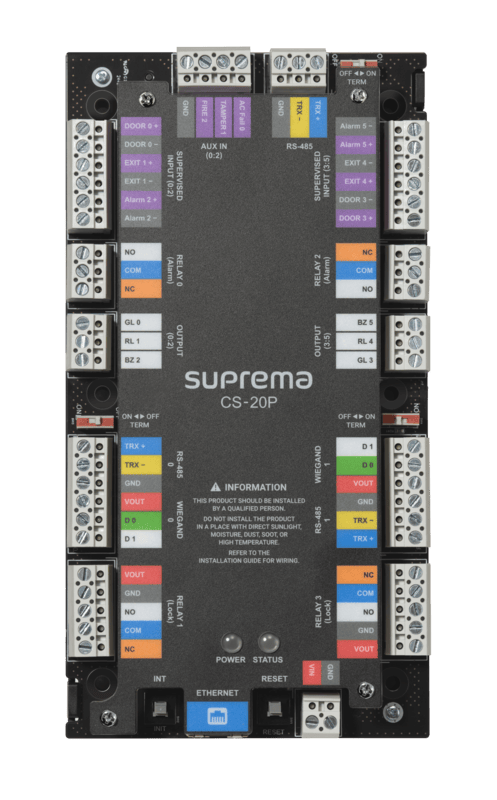
Supervised inputs port 0:2
SUPERVISED INPUT terminals can be set to be used for normal TTL input or supervised input.
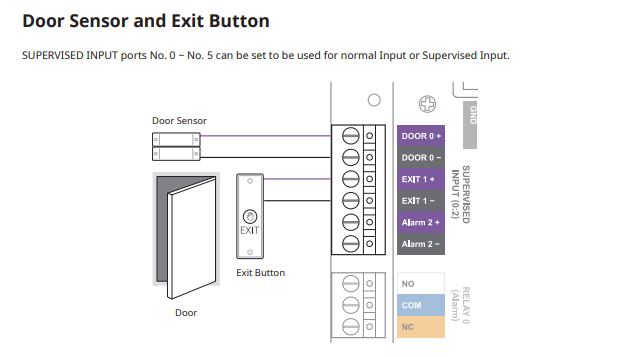
Auxiliary
Tamper Connection
A power failure detector, a tamper, or a fire detector can be connected to the AUX IN port.
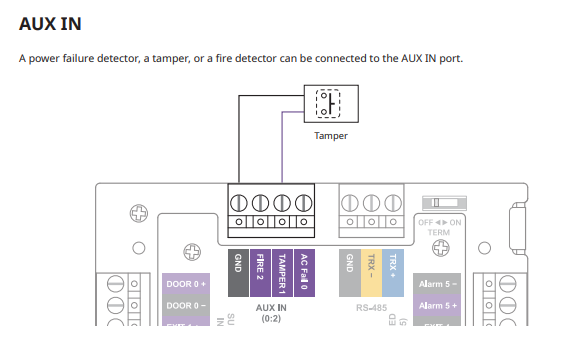
Supervised inputs port 3:5
SUPERVISED INPUT terminals can be set to be used for normal TTL input or supervised input.

Relay port 0
Relay
CoreStation 20 has two types of relay ports: Alarm and Lock, each can be used for specific purposes.
• Alarm: Can be connected to devices that generate warning sounds or intrusion alerts, such as warning lights,
sirens, or buzzers.
• Lock: Can be connected to devices for door locking and unlocking, such as electric strike locks or magnetic locks.
Connect a diode to both ends of the power input as shown in the figure below when installing a deadbolt or a door strike. Make sure to connect the Cathode (direction to the stripe) to the + part of the power while paying attention to the direction of the diode.
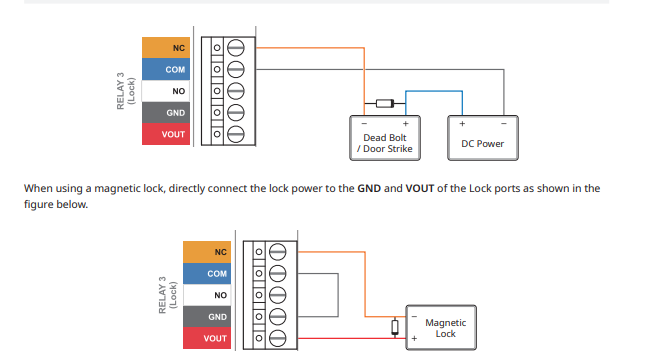
Relay port 2
Relay
CoreStation 20 has two types of relay ports: Alarm and Lock, each can be used for specific purposes.
• Alarm: Can be connected to devices that generate warning sounds or intrusion alerts, such as warning lights,
sirens, or buzzers.
• Lock: Can be connected to devices for door locking and unlocking, such as electric strike locks or magnetic locks.
Connect a diode to both ends of the power input as shown in the figure below when installing a deadbolt or a door strike. Make sure to connect the Cathode (direction to the stripe) to the + part of the power while paying attention to the direction of the diode.

Outputs 0:2
The outputs are used to send signals to devices using time to live messages, these can range from alarms, sensors or input boards that need a controller.
Outputs can be set using the trigger and action function within Biostar or on the Device config
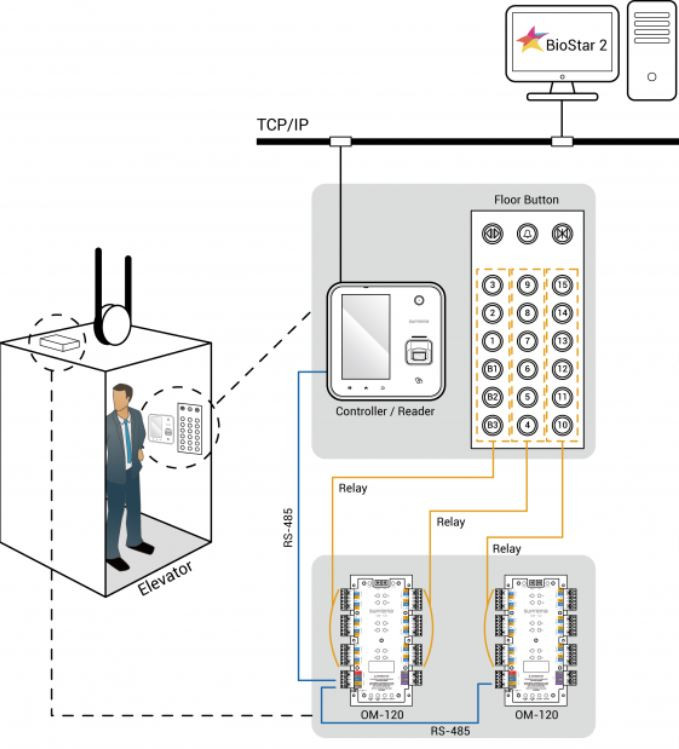
Outputs 3:5
The outputs are used to send signals to devices using time to live messages, these can range from alarms, sensors or input boards that need a controller.
Outputs can be set using the trigger and action function within Biostar or on the Device config

RS-485 port 0
RS-485 Connection
CoreStation 20 supports three RS-485 ports and, by daisy-chaining Door Interface, can configure up to 34 doors.
• The total number of RS-485 devices connected to CoreStation 20 cannot exceed 84. (Including Door
Interface)
• A maximum of two devices can be connected to each RS-485 0 and RS-485 1 port.
• If more than three devices are connected to a single RS-485 port, the desired device may not appear in the
available device list when searching for slave devices.
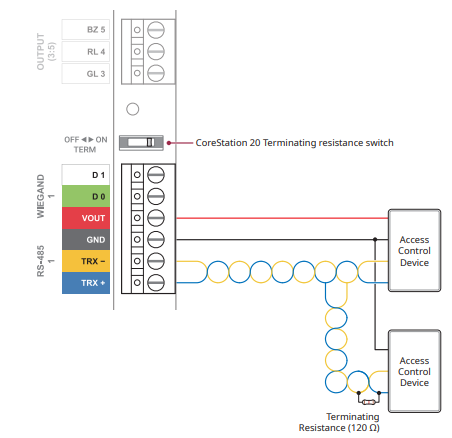
RS-485 port 1
RS-485 Connection
CoreStation 20 supports three RS-485 ports and, by daisy-chaining Door Interface, can configure up to 34 doors.
• The total number of RS-485 devices connected to CoreStation 20 cannot exceed 84. (Including Door
Interface)
• A maximum of two devices can be connected to each RS-485 0 and RS-485 1 port.
• If more than three devices are connected to a single RS-485 port, the desired device may not appear in the
available device list when searching for slave devices.

Power
Power Connection Consists of a 12V 3A DC input The Corestation requires 1.5A and can emit 1.5A to external devices, it is recommended to connect an uninterruptible power supply to prevent power failure.

Power
Power Connection Consists of a 12V 3A DC input The Corestation requires 1.5A and can emit 1.5A to external devices, it is recommended to connect an uninterruptible power supply to prevent power failure.

Wiegand port 1
The power output (12V, up to 1.5A) of CoreStation-20 can be used as the power for a Wiegand device when CS-20and the Wiegand device are connected. In other words, when 3 Wiegand devices that consume 200mA are connected, a device that consumes up to 900mA can be connected to the remaining power output terminal.
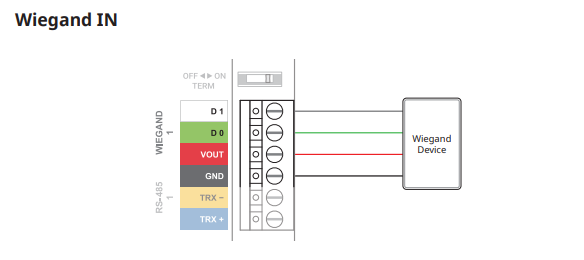
Wiegand port 0
The power output (12V, up to 1.5A) of CoreStation-20 can be used as the power for a Wiegand device when CS-20 and the Wiegand device are connected. In other words, when 3 Wiegand devices that consume 200mA are connected, a device that consumes up to 900mA can be connected to the remaining power output terminal.

Relay port 1
Relay
CoreStation 20 has two types of relay ports: Alarm and Lock, each can be used for specific purposes.
• Alarm: Can be connected to devices that generate warning sounds or intrusion alerts, such as warning lights,
sirens, or buzzers.
• Lock: Can be connected to devices for door locking and unlocking, such as electric strike locks or magnetic locks.
Connect a diode to both ends of the power input as shown in the figure below when installing a deadbolt or a door strike. Make sure to connect the Cathode (direction to the stripe) to the + part of the power while paying attention to the direction of the diode.

Relay port 3
Relay
CoreStation 20 has two types of relay ports: Alarm and Lock, each can be used for specific purposes.
• Alarm: Can be connected to devices that generate warning sounds or intrusion alerts, such as warning lights,
sirens, or buzzers.
• Lock: Can be connected to devices for door locking and unlocking, such as electric strike locks or magnetic locks.
Connect a diode to both ends of the power input as shown in the figure below when installing a deadbolt or a door strike. Make sure to connect the Cathode (direction to the stripe) to the + part of the power while paying attention to the direction of the diode.

Power
Power Connection Consists of a 12V 3A DC input The Corestation requires 1.5A and can emit 1.5A to external devices, it is recommended to connect an uninterruptible power supply to prevent power failure.

Power
Power Connection Consists of a 12V 3A DC input The Corestation requires 1.5A and can emit 1.5A to external devices, it is recommended to connect an uninterruptible power supply to prevent power failure.

Power In
Power Connection Consists of a 12V 3A DC input The Corestation requires 1.5A and can emit 1.5A to external devices, it is recommended to connect an uninterruptible power supply to prevent power failure.
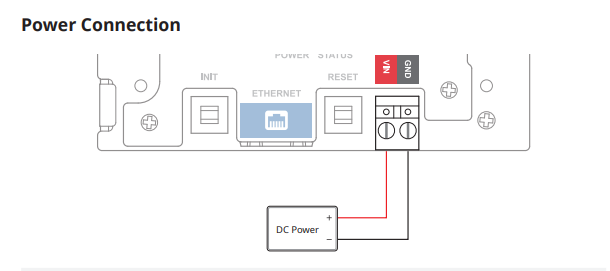
Ethernet
CS-20 has automatic MDI/MDI-X function, so it can be connected to a PC directly using a normal type CAT-5e cable.
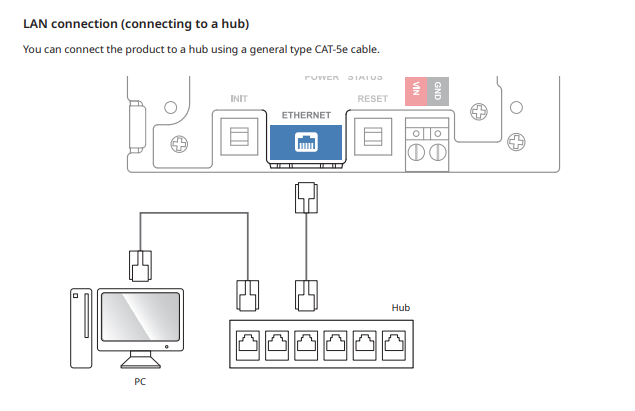
RS-485 Host
RS-485 Connection
CoreStation 20 supports three RS-485 ports and, by daisy-chaining Door Interface, can configure up to 34 doors.
• The total number of RS-485 devices connected to CoreStation 20 cannot exceed 84. (Including Door
Interface)
• A maximum of two devices can be connected to each RS-485 0 and RS-485 1 port.
• If more than three devices are connected to a single RS-485 port, the desired device may not appear in the
available device list when searching for slave devices.

Init
The init button is used to reset the connection of the Secure I/O from a previously connected device, it removes the certificates of the previous device back to factory.
Reset
The Reset button interrupts the power of the device, this stops you having to remove the power cable from the device to reboot it.
RS-485 Termination
In case that the RS-485 cable characteristic impedance is 120ohm, switch ON terminating resistance of CS-20 and install 120ohm terminating resistance to reader.
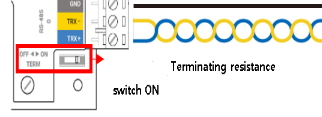
RS-485 Termination
In case that the RS-485 cable characteristic impedance is 120ohm, switch ON terminating resistance of CS-20 and install 120ohm terminating resistance to reader.

RS-485 Termination
In case that the RS-485 cable characteristic impedance is 120ohm, switch ON terminating resistance of CS-20 and install 120ohm terminating resistance to reader.
